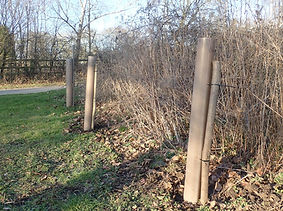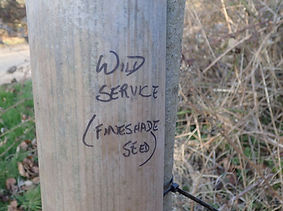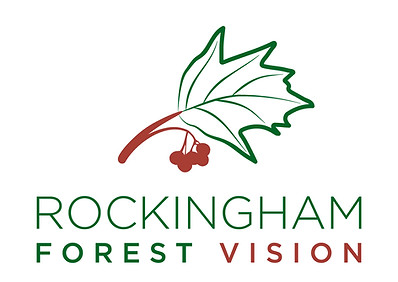
Friends of Fineshade

Fineshade's Wild Service Trees
The Wild Service is a native deciduous tree but is fairly rare, occurring mainly in Ancient Woodlands and hedgerows on clay or limestone. There are many fine examples in Fineshade, for example one grows immediately in front of the wildlife hide and another on the south side of Justice Riding beside the Smelters Trail.
It is a very attractive tree. In spring, Wild Service Trees have white flowers in branched clusters, and by autumn these have changed into russet-brown fruits which taste something like dates. They are sometimes called chequers and before the introduction of hops, they were used to flavour beer. It is suggested that this may be the reason for so many old pubs to be called The Chequers.
The tree has long been known in northern Northamptonshire and north western Cambridgeshire in the old Rockingham Forest area. The early 19th century poet John Clare, who came from this neighbourhood, was familiar with the tree and called it by its local name of Surrey as well as Service Tree in his writing. It is reported that parish bounds in the Rockingham Forest area used to be beaten with branches of this tree, and the branches also used to be carried at the head of village processions. (Source: The distribution of the Wild Service Tree)

Right, a mature Wild Service in autumn.
Left the distinctively shaped leaves and bunches of flowers in spring.
Below, the fruit or chequers forming in later summer
All photos, Barrie Galpin


Where exactly and how many?
Friends of Fineshade have been carefully recording the Wild Service trees over the years, passing these records on to Forestry England to try to ensure that these rare trees are not felled inadvertently in the course of forest management works. By October 2021 our database contained records of 137 individual trees in 62 separate locations.
There are individual trees scattered throughout the wood but three particular concentrations. There are at least 17 good examples around the edge of a plantation in Dales Wood (SP983992) - you can see some of these on your left if you follow the Dales Wood marked trail. They are just beyond the top of the long straight hill. Two other groups are along both sides of the old railway line (Far Hazelwood-Britain Sale area SP983974) and mixed in with Scots Pine in Far Markham's Wood (SP980988).
Propagating Wild Service trees
Wild Service propagate by means of both suckers and seed. Once the chequers ripen in autumn they are eaten by birds who then cause the seed to be dispersed. Following our success in propagating seed from Fineshade's Elms (see here for full details) former Wildlife Ranger, Richard Eckton suggested that we might try to do something similar with the Wild Service trees. Discussions with various Forestry England staff were very positive. There were even suggestions that it may be possible to experiment with planting Wild Service as a potential crop.
With the Elms we had managed to produce a few hundred seedlings for planting, but to plant up a hectare of land with Wild Service would probably need 2000- 3000 plants! What would the germination rate be like? How many chequers would we need?
With encouragement and support from Scott Martin, the local FE forester, the Friends of Fineshade collected as many chequers as we could in October 2019. We revisit all the known Wild Service in order to choose trees from across Fineshade that
-
were a good shape (straight trees required for productive timber),
-
had a good crop of chequers (many trees had very few, especially where they were competing for sun light)
-
had low hanging fruit that we would be able to reach from ground level.
Would we be able to find sufficient fruit?
On a grey, damp October day an intrepid team of four began the collection. Very soon our buckets began to fill - had we got enough? After a morning's work we returned to base and found we had about 9kg of fruit. We counted out 100 chequers and these weighed 100g, so it seemed that we must have around 9000 chequers - probably enough!
The fruit was transported north to be processed in a nursery in Northumberland. It is said that the seeds need 30 weeks' severe cold before they germinate. But with a bit of luck these chequers would produce healthy seedlings for planting out in Fineshade and elsewhere in Rockingham Forest in due course.



Update 2020-21
Because of the confusion caused by the Covid pandemic we have, so far, been unable to trace what happened to the 2019 crop of chequers. Were they actually planted? If so, what was germination like? Or perhaps they are still somewhere in a deep freeze waiting to be dealt with.
However, back in Fineshade three seedlings that had been planted as an experiment had grown very healthily. They were planted out near the houses at Top Lodge along with some Fineshade Elms - fingers crossed!


October 2021
We were very pleased to be contacted by Hugh Dorrington, the owner of Aveland Trees Ltd. a nursery in Lincolnshire which specialises in growing native trees and shrubs from seed. Hugh expressed interest in growing Wild Service from Fineshade stock - if we could provide the chequers, he would sow them and hope to supply us with young trees ready for planting in a year's time.
So on a bright cold October morning Adam and Mary Cade joined Tricia and Barrie Galpin to harvest chequers. This year different trees were bearing a good crop but again many of them had very little fruit indeed. However, after a hard morning's work we had nearly filled two buckets - about 11kg, so probably around 11,000 chequers. Once again we will wait for news of the germination rate and hope very much to have trees to plant in Fineshade and the wider Rockingham Forest next year.
Read more about Sorbus torminalis
Wild Service Trees and Redwings:
a fascinating blog post by Hugh Dorrington.
New trial to make case for overlooked hardwood: a press release from Woodland Heritage reports on a project to trial Wild Service seed from different sources.



